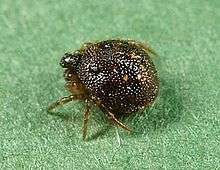Phoroncidia
Phoroncidia is a genus of comb-footed spiders that was first described by J. O. Westwood in 1835.[4]
| Phoroncidia | |
|---|---|
 | |
| Phoroncidia ryukyuensis | |
| Scientific classification | |
| Kingdom: | Animalia |
| Phylum: | Arthropoda |
| Subphylum: | Chelicerata |
| Class: | Arachnida |
| Order: | Araneae |
| Infraorder: | Araneomorphae |
| Family: | Theridiidae |
| Genus: | Phoroncidia Westwood, 1835[1] |
| Type species | |
| P. aculeata Westwood, 1835 | |
| Species | |
|
79, see text | |
| Synonyms[1] | |
Species
As of May 2020 it contains seventy-nine species and one subspecies, found worldwide:[1]
- P. aciculata Thorell, 1877 – Indonesia (Sulawesi)
- P. aculeata Westwood, 1835 (type) – India, China
- P. alishanensis Chen, 1990 – Taiwan
- P. altiventris Yoshida, 1985 – Japan
- P. alveolata (Simon, 1903) – Equatorial Guinea
- P. ambatolahy Kariko, 2014 – Madagascar
- P. americana (Emerton, 1882) – USA, Canada, Cuba, Jamaica
- P. argoides (Doleschall, 1857) – Indonesia (Ambon)
- P. aurata O. Pickard-Cambridge, 1877 – Madagascar
- P. bifrons (Simon, 1895) – Philippines
- P. biocellata (Simon, 1893) – Brazil
- P. bukolana Barrion & Litsinger, 1995 – Philippines
- P. capensis (Simon, 1895) – South Africa
- P. concave Yin & Xu, 2012 – China
- P. coracina (Simon, 1899) – Indonesia (Sumatra)
- P. cribrata (Simon, 1893) – Paraguay
- P. crustula Zhu, 1998 – China
- P. cygnea (Hickman, 1951) – Australia (Tasmania)
- P. eburnea (Simon, 1895) – South Africa
- P. ellenbergeri Berland, 1913 – Gabon
- P. escalerai (Simon, 1903) – Equatorial Guinea
- P. flavolimbata (Simon, 1893) – Ecuador
- P. floripara Gao & Li, 2014 – China
- P. fumosa (Nicolet, 1849) – Chile
- P. gayi (Nicolet, 1849) – Chile
- P. gira Levi, 1964 – Venezuela
- P. hankiewiczi (Kulczyński, 1911) – Portugal, Spain, France
- P. hexacantha Thorell, 1890 – Indonesia (Sumatra)
- P. jacobsoni (Reimoser, 1925) – Indonesia (Sumatra)
- P. kibonotensis (Tullgren, 1910) – East Africa
- Phoroncidia k. concolor (Caporiacco, 1949) – Kenya
- P. levii Chrysanthus, 1963 – New Guinea
- P. longiceps (Keyserling, 1886) – Brazil
- P. lygeana (Walckenaer, 1841) – Malaysia, Indonesia (Sumatra, Java, Borneo)
- P. maindroni (Simon, 1905) – India
- P. minuta (Spassky, 1932) – Georgia, Azerbaijan
- P. moyobamba Levi, 1964 – Peru, Brazil
- P. musiva (Simon, 1880) – New Caledonia
- P. nasuta (O. Pickard-Cambridge, 1873) – Sri Lanka, Taiwan, Japan
- P. nicoleti (Roewer, 1942) – Chile
- P. nicoleti Levi, 1964 – Chile
- P. oahuensis (Simon, 1900) – Hawaii
- P. paradoxa (Lucas, 1846) – Southern Europe, North Africa, Turkey
- P. pennata (Nicolet, 1849) – Chile
- P. personata (L. Koch, 1872) – Samoa, Fiji, Australia (Lord Howe Is.)
- P. pilula (Karsch, 1879) – Georgia, Russia (Far East), China, Korea, Japan
- P. pilula (Simon, 1895) – Tanzania (Zanzibar)
- P. piratini Rodrigues & Marques, 2010 – Brazil
- P. pukeiwa (Marples, 1955) – New Zealand
- P. puketoru (Marples, 1955) – New Zealand
- P. puyehue Levi, 1967 – Chile
- P. quadrata (O. Pickard-Cambridge, 1880) – New Zealand
- P. ravot Levi, 1964 – Venezuela
- P. reimoseri Levi, 1964 – Brazil
- P. roseleviorum Kariko, 2014 – Madagascar
- P. rotunda (Keyserling, 1890) – Australia (Queensland, Lord Howe Is.), Samoa
- P. rubens Thorell, 1899 – Cameroon
- P. rubroargentea Berland, 1913 – Madagascar
- P. rubromaculata (Keyserling, 1886) – Brazil
- P. ryukyuensis Yoshida, 1979 – Taiwan, Japan (Ryukyu Is.)
- P. saboya Levi, 1964 – Colombia
- P. scutellata (Taczanowski, 1879) – Peru
- P. scutula (Nicolet, 1849) – Bolivia, Chile
- P. septemaculeata O. Pickard-Cambridge, 1873 – India, Sri Lanka, Malaysia
- P. sextuberculata (Keyserling, 1890) – Australia (Queensland)
- P. sjostedti Tullgren, 1910 – Tanzania
- P. spissa (Nicolet, 1849) – Chile
- P. splendida Thorell, 1899 – West Africa
- P. studo Levi, 1964 – Peru, Brazil
- P. testudo (O. Pickard-Cambridge, 1873) – India, Sri Lanka
- P. thwaitesi O. Pickard-Cambridge, 1869 – Sri Lanka
- P. tina Levi, 1964 – Brazil
- P. tricuspidata (Blackwall, 1863) – Brazil
- P. trituberculata (Hickman, 1951) – Australia (Tasmania)
- P. triunfo Levi, 1964 – Mexico to Costa Rica
- P. truncatula (Strand, 1909) – South Africa
- P. umbrosa (Nicolet, 1849) – Chile
- P. variabilis (Nicolet, 1849) – Chile
- P. vatoharanana Kariko, 2014 – Madagascar
- P. wrightae Kariko, 2014 – Madagascar
Formerly included:
- P. flavomaculata (Keyserling, 1891) (Transferred to Dipoena)
- P. sudabides (Bösenberg & Strand, 1906) (Transferred to Chrosiothes)
- P. quadrispinella Strand, 1907
gollark: So presumably that.
gollark: Well, if you believe in yourself, you can do anything.
gollark: Technically speaking, it already is.
gollark: Admittedly Milo Remote already has this and it uses your inventory, but still.
gollark: It can interface with its control server via SPUDNET and ender chests, freeing you from the tyranny of actually going to your base.
See also
References
- "Gen. Phoroncidia Westwood, 1835". World Spider Catalog Version 20.0. Natural History Museum Bern. 2020. doi:10.24436/2. Retrieved 2020-06-30.
- Levi, H. W.; Levi, L. R. (1962). "The genera of the spider family Theridiidae". Bulletin of the Museum of Comparative Zoology. 127: 29.
- Levi, H. W. (1964). "American spiders of the genus Phoroncidia (Araneae: Theridiidae)". Bulletin of the Museum of Comparative Zoology. 131: 72.
- Westwood, J. O. (1835). "Insectorum Arachnoidumque novorum Decades duo". The Zoological Journal. 5: 440–453.
Further reading
- Nicolet, H. (1849), "Aracnidos", in Gay, C. (ed.), Historia física y política de Chile
- Simon, E (1894). Histoire naturelle des araignées (in French). Paris: Roret. doi:10.5962/bhl.title.51973.
This article is issued from Wikipedia. The text is licensed under Creative Commons - Attribution - Sharealike. Additional terms may apply for the media files.